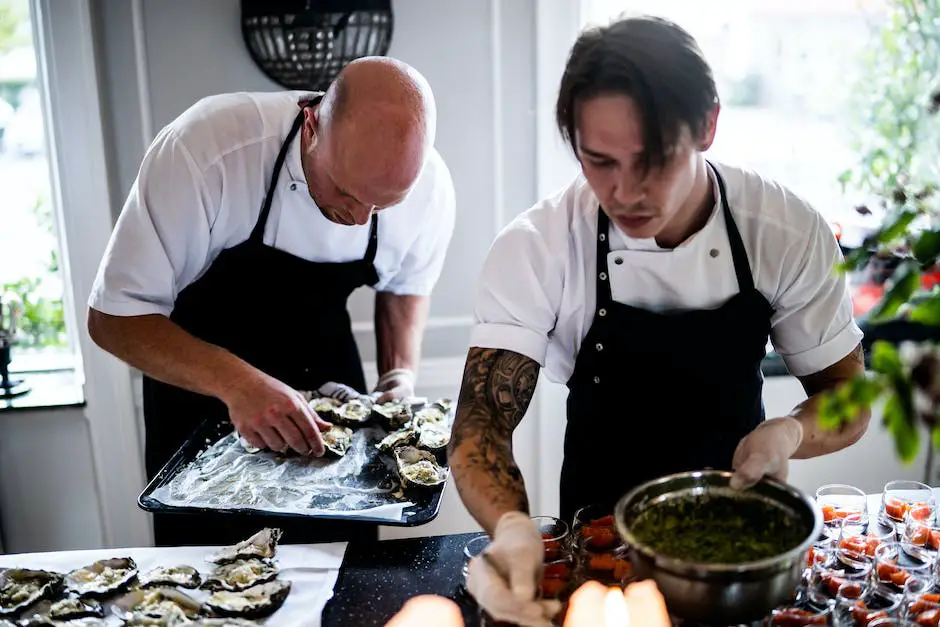Why Do Chefs Wear White

Chefs have been wearing white for centuries, and the practice continues today. Wearing white in the kitchen is more than just a fashion choice — it’s an important part of being a professional chef. A white uniform serves several purposes, from maintaining safety to making chefs stand out in a crowd. The cleanliness and simplicity of a white uniform also helps chefs express their commitment to quality and excellence in their work.Chefs wearing white is significant for a number of reasons. Firstly, white clothing is associated with cleanliness, so it helps to convey the idea that a kitchen is being kept in a sterile environment. The colour also provides chefs with a sense of professionalism, as it has been traditionally associated with chefs and other culinary professionals. Additionally, wearing white helps chefs to keep cool in the often hot and humid kitchen environments. Lastly, a chef’s white clothing helps to make them easily identifiable by customers and staff alike.
A History of Chefs Wearing White
Chefs wearing white has been a uniform tradition in the culinary world for centuries. In fact, it is thought to have originated in the 18th century, when French chefs began donning white coats and hats to signify their professionalism. This trend quickly spread across Europe and beyond, and by the mid-19th century, chefs all over the world were wearing white.
The practice of wearing white was further popularized in the early 1900s when French chef Auguste Escoffier wrote about it in his book Le Guide Culinaire. He argued that “the whiteness of the dress serves to emphasize cleanliness… a chef must wear a spotless uniform”. He also claimed that wearing white was a sign of respect for the ingredients they were working with.
The tradition continued into the 20th century and remains an important part of any professional kitchen today. It is thought that by wearing white, chefs not only project an image of professionalism and cleanliness, but also demonstrate their dedication to their craft. Professional chefs take pride in their appearance and strive to look clean and presentable at all times.
In some parts of Europe, chefs still wear traditional chef’s whites complete with tall hats and neckerchiefs. This type of attire is becoming less common as modern kitchens opt for more practical uniforms such as aprons and comfortable clothing instead. However, regardless of what type of attire they choose to wear, most professional chefs agree that keeping a clean appearance is essential to maintain credibility in the kitchen.
Today, it is clear that wearing white has become an integral part of being a professional chef; from serving as a symbol of cleanliness to demonstrating respect for one’s craft and ingredients. It is no surprise then that many aspiring chefs will go out of their way to ensure they look presentable while on duty – after all, it’s a part of what makes them stand out from the crowd!
The Practicality of White Uniforms for Chefs
White uniforms have long been the standard for chefs in professional kitchens. But why is this? Is it simply a matter of tradition, or is there something more to it? In fact, white uniforms for chefs are not only practical, but they also make sense from both a safety and hygiene perspective.
When it comes to safety, white chef’s uniforms are much less likely to catch fire than other colors. The natural fibers used in traditional chef’s uniforms are highly flammable, so having a lighter color helps reduce the risk of an accident in the kitchen. Additionally, lighter colored fabrics reflect heat more effectively than darker fabrics, helping to keep chefs cooler in hot environments.
From a hygiene standpoint, white uniforms for chefs also make sense. In professional kitchens, hygiene is paramount – and white garments are much easier to keep clean than other colors. Not only do they show dirt and stains less easily, but they can also be bleached – something which cannot be done with darker uniforms. Additionally, since whites reflect light better than darker colors do, they’re less likely to harbor bacteria or other microorganisms that can lead to food-borne illnesses.
For these reasons and more, white has been the traditional color choice for chef’s uniforms since the days of Escoffier himself. While it is possible to find alternative colors available on the market today – such as blues and greens – white will always remain the preferred choice for professional chefs due to its practicality and superior safety and hygiene benefits.
Advantages of Wearing White for Chefs
Chefs wear white in the kitchen as it is a traditional part of the profession. It has many advantages, such as providing a sense of professionalism, conveying that the chef is competent and trustworthy, and creating a clean working environment. Wearing white also creates an air of authority in the kitchen, because it showcases the skills and experience of the chef. The all-white look also helps to create a more unified team dynamic among the kitchen staff. Additionally, wearing white can help to protect chefs from potential burns and spills while they are cooking. It also serves as an effective way to keep track of any potential food safety hazards in the kitchen.
Disadvantages of Wearing White for Chefs
The main disadvantage of wearing white for chefs is that it can be difficult to keep clean. With all the spills and splatters that occur in a professional kitchen, it can be hard to maintain a pristine all-white look throughout an entire shift. Additionally, wearing all-white can be hot and uncomfortable in warm kitchens, which can be distracting for chefs while they are preparing meals. Furthermore, some chefs may find that wearing all-white restricts their creativity when designing dishes or plating them. Finally, some chefs may feel limited by traditional expectations when wearing white in the kitchen.
Cleanliness and Hygiene Benefits of White Uniforms for Chefs
The white uniform has been a staple of the culinary world since the early nineteenth century. Not only does it provide a professional appearance, but white uniforms also offer important cleanliness and hygiene benefits for chefs. White uniforms are easier to keep clean and present a more hygienic appearance than darker colors, which can mask stains or dirt. In addition, white uniforms can be quickly and easily bleached or disinfected to reduce the spread of foodborne illness.
White uniforms also help to create a sense of cleanliness and professionalism in the kitchen. Chefs wearing white uniforms are less likely to have their clothing come into contact with food or kitchen surfaces, which helps to prevent cross-contamination between ingredients. Furthermore, it is much easier to spot any spills or splashes on a white uniform than on darker colored clothing. This makes it easier for chefs to maintain a clean work environment and ensure that food safety standards are met at all times.
Finally, wearing a white uniform helps to create an atmosphere of respect in the kitchen. White is traditionally associated with professionalism and authority, so having chefs dressed in white conveys an air of expertise and trustworthiness among customers and colleagues alike. In addition, wearing matching uniforms helps to create a sense of camaraderie among team members while still maintaining an air of professionalism in the workplace.
Overall, there are numerous benefits associated with white uniforms for chefs. From being easy to keep clean and providing hygiene benefits to creating an atmosphere of respect in the kitchen, these uniforms can help promote a professional image while also promoting cleanliness and safety in the workplace.

Protection from Heat Related Injuries with White Uniforms for Chefs
Chefs work in the kitchen under very hot temperatures. They need to wear appropriate clothing that will provide protection from heat related injuries. White uniforms are one of the best choices for chefs who work in hot kitchens. The white color absorbs less heat and helps keep the chef cool while cooking. The uniform also provides protection from burns, as it is made of fire-resistant material that can withstand high temperatures. It also protects against grease and oils splashing onto the chef’s skin.
White uniforms for chefs are also available in a variety of styles, so chefs can choose whichever style is most comfortable for them while working in the kitchen. The uniform should be lightweight and breathable, so that it does not restrict the chef’s movement or add extra heat to the environment. Chefs can also customize their uniform by adding embroidery or logos to make it unique and personalized.
Overall, white uniforms are a great way for chefs to protect themselves from heat related injuries while working in the kitchen. They provide protection from burns, grease, and oils, and they come in a variety of styles so that chefs can find one that is comfortable and allows them to move freely while cooking. With white uniforms, chefs can stay safe and look great at the same time!
The Role of Traditions in Why Do Chefs Wear White
Traditions are an important part of the culinary world, and the practice of wearing white while working in a professional kitchen is no exception. Wearing white has been a long-standing tradition among chefs, and there are several reasons why it has become such an integral part of the profession.
One reason for wearing white in the kitchen is to signify cleanliness and hygiene. White is often associated with sterility, which is why medical personnel wear it as well. In a professional kitchen, cleanliness and hygiene are paramount due to the potential health risks posed by unhygienic practices. By wearing white, chefs can demonstrate to their customers that they take food safety seriously and that they are working hard to maintain a safe environment for preparing food.
Another reason for wearing white is to project a sense of professionalism and authority. Professional chefs have often been seen as authority figures in the culinary world, so wearing white can be seen as an outward sign of that status. The uniformity created by having everyone in the kitchen dress in similar attire provides a sense of order and structure that can help chefs maintain control over their workspace.
Finally, wearing white is also seen as a sign of respect for culinary traditions. Culinary schools often require students to wear all-white uniforms when they’re learning how to cook, as a way of honoring traditional techniques and recipes that have been passed down from generation to generation. In this way, wearing all-white helps honor those who came before us while providing a unified look among current chefs.
Overall, there are many reasons why chefs choose to wear all-white while on duty in the kitchen. From promoting cleanliness and hygiene to creating uniformity among staff members, this tradition has become an integral part of what it means to be a professional chef today.

Conclusion
Chefs wearing white has a long history and has become a symbol of professionalism and cleanliness in the kitchen. It also serves as a reminder for chefs to maintain hygiene standards, as well as to protect their clothes from cooking splatters. Wearing white also helps ensure that chefs are easily identifiable, especially when working in a team. The color white is also associated with trustworthiness and authority, making it easier for customers to identify the chef in charge of their meal. All these reasons explain why chefs wear white and why it is an important part of professional cooking.
Overall, the tradition of wearing white in the kitchen is an important part of culinary culture that will likely continue for many years to come. Chefs wear white not only because it looks professional but also because it serves many practical purposes as well. Whether you are just starting out in a kitchen or are an experienced chef, wearing white can be beneficial for both you and your customers.
